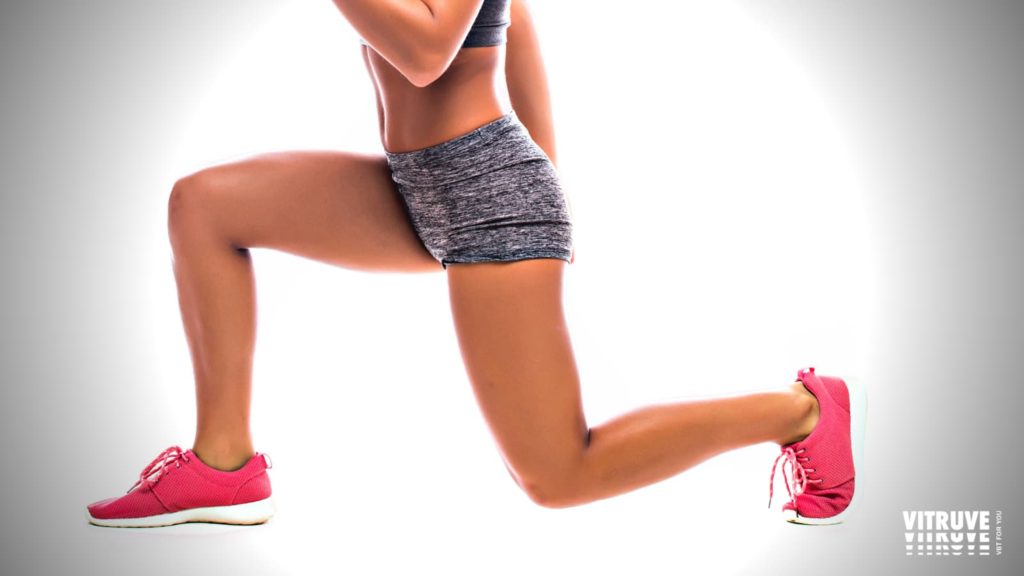10 de March de 2022
Common Mistakes Of Deficit Lunge
If you’re having trouble with the strain on your knee joint doing forward lunges, or if you’re having a hard time keeping your back upright, you can turn things around and do a deficit (or reverse) lunge instead. In deficit lunges, The foot is placed backward and not forward. This keeps you stable and allows you to move more deeply, which in turn has a positive effect on gluteus training.
Explanation Of The Exercise
Even without training equipment, you can easily train your buttocks and thighs. In general, lunges are recommended for training these muscle groups. However, if you have problems in the knee area, you can use this exercise variant, since the knee joints are significantly less stressed when moving backward than in the classic exercise with a step forward.
In general, this exercise works the gluteus maximus muscle and the quadriceps femoris muscle. However, the two heads of the thigh flexor (musculus biceps femoris) are also trained to a small extent.
Benefits Of Deficit Lunge Exercis
In addition to correcting right to left imbalances, it closely resembles sports and everyday activities, it helps build bilateral strength, and it is generally safer than other methods.
In addition, it minimizes spinal load. It’s not necessary to use much weight on deficit lunges because they’re already pretty challenging. While it is certainly possible to load up a barbell, the weight requirement will be lower than other exercises such as the back squat. It is always good to get a similar training effect with less strain on your spine.

The Execution
Stand up straight and position your feet about hip-width apart. Your torso is erect, your abs are tight, and your lower back is slightly arched to protect your discs.
You start the actual exercise by taking a wide step backward with one leg. As you do this, breathe in. Make sure that the step is as big as possible so that your lower leg and thigh of the front leg form an angle of about 90 degrees.
Then exhale and at the same time push yourself back to the starting position over the heel of the back leg. Your upper body remains completely upright throughout the movement.
Common Mistakes
Bending the front leg to an acute angle that is less than the 90 degrees recommended above is often wrong. The reason for this is a too small step backward, which also ensures that the front knee is in front of the toes. This puts a lot of strain on the knee joint, which in turn can lead to knee problems. You should therefore choose the step back as long as possible to ensure at least a right angle between the upper and lower leg of the front leg and to avoid injuries in the knee area.
In addition, Your front knee should be parallel to your second toe when you step back. Do not let your knee cave in. The same applies to any lower body exercise, especially to single-leg exercises. In situations in which the knee moves inside the toes, it places a great deal of unnecessary strain on the joints, causing pain and injury.
Furthermore, you shouldn’t slam the back knee on the ground Simply put, this is going to hurt you for no reason at all. When it comes to the training aspect of this, slamming the ground signifies you are not controlling the movement. Without control, there is no tension in the muscles, which means no growth. Be sure to keep tension and control the entire time and gently lift that back knee off the ground.
Final Thoughts
Lunges can be performed in many different ways, each with its own distinct benefit. The universal rule of thumb is to perform the exercise perfectly and avoid injuries. It may seem simple to do the deficit lunge, but there are many mistakes you can make that turn it into a meaningless stack of movements that are useless other than getting you sweaty and increasing your risk of injury. So it is advised to learn the exercise first and execute it in a controlled manner.
If you are looking to reach your fullest potencial as an athlete and you want to learn more about sport science, VBT training and how to improve your workout routine, we have lots of articles that can help you achieve your goal. If you have any questions, don’t hesitate to ask! Leave a comment or contact us here.

